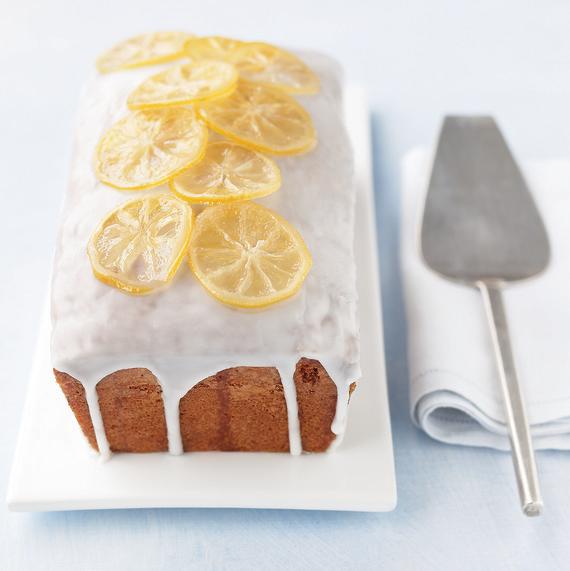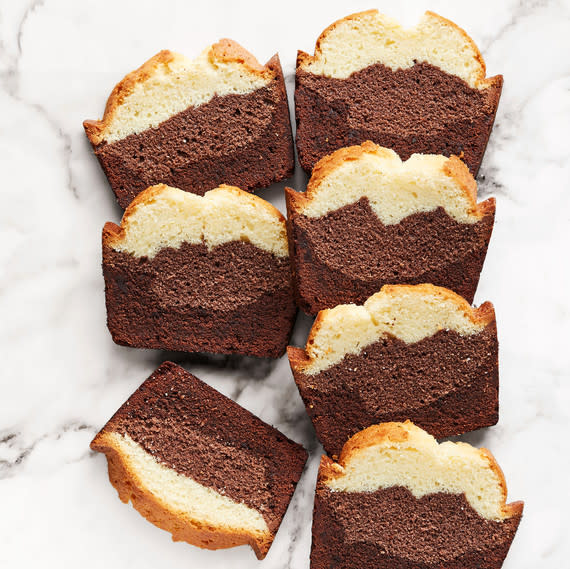Is,pound Cake The Same As Short

Think of pound block as the original no-recipe recipe. Information technology takes its proper name from the weight of its four crucial ingredients—flour, saccharide, butter, and eggs. Traditionally, the block was fabricated from one pound of each. The title itself serves as a mnemonic device. If you can recollect the ratio (1:1:1:ane), or simply the catchphrase "all things being equal," you lot can bake a pound block from memory.
Similar many beloved American desserts, pound block originated in England, though the French take long had their own version, known as quartre-quarts, or "4-fourths." The English brought the cake and its no-recipe recipe with them, and in brusque order, the dessert fabricated its fashion onto sideboards and tea trays throughout the colonies. Recipes for pound cake appeared in the first American cookbook, Amelia Simmons's American Cookery, published in Hartford, Connecticut in 1796. Though many associate pound cakes with the American Southward, in truth, they have long been pop from declension to declension.
Related: The History of the Angel Nutrient Cake
The original, four-pound cakes were made to serve large groups and were normally prepared by commercial bakers and pastry chefs. Over time, recipes were scaled down to more practical proportions, a benefaction for home bakers. Proportions and recipes were tinkered with further, and many bakers adult variations all their own. Some added leavening agents such as baking pulverization or soda. Others replaced some of the butter with other dairy-based staples like sour foam, cream cheese, buttermilk, or heavy cream. Others flavored their cakes with footing nuts or spices (cardamom is especially lovely and warming) and extracts such equally vanilla or almond. (Notably, one of the two recipes for pound block in American Cookery includes rosewater.)

Shape-wise, most people retrieve of loaves when they imagine pound cakes, well-nigh likely due to the popularity of store-bought options like the dear All Butter Pound Cake from Sara Lee. The Chicago bakery, named for owner Charlie Lubin'south young daughter, introduced its pound block in 1951. A few years later, due to developments in freezing and preservation techniques, Sara Lee (the visitor, which grew from the original bakery) was able to transport frozen pound cakes to 48 states without losing the fresh-baked taste and texture. The cakes have been freezer-aisle favorites in grocery stores nationwide in the 60 years since.
Ring-shaped pound cakes are also quite pop. These are broiled in tube pans, including the German kugelhopf and its American counterpart, the Bundt. (Coincidentally, the Bundt pan was developed in the Midwest around the same fourth dimension that the Sara Lee bakery sold its first pound cake. H. David Dalquist, possessor of Minnesota's Nordic Ware, introduced the Bundt pan in 1950.) Thought in that location's no real divergence in flavour between the 2 shapes, some professional bakers adopt the texture of tube-shaped cakes. As Nick Malgieri, a blistering instructor and author of several baking cookbooks, writes in Perfect Cakes, "I find that pound cakes take an fantabulous texture and superior lightness when they are broiled in a tube pan. A tube pan too bakes the block more than chop-chop considering of the heat conducted into the center of the pan through the tube, and this makes for a moister cake."
Related: Lemon Pound Cake with Citrus Coat

Advice for Making Pound Block
Beyond shape, the components of a basic pound cake remain largely the same. Because there are so few ingredients, quality is everything. Seek out the freshest ingredients you can find, especially butter. Information technology is the dominant flavour of any good pound block, then cull a brand that tastes of nothing but pure, sweetness cream.
Achieving just the correct texture for pound cake—rich and dense, non at all heavy or greasy—depends on creaming the butter and sugar thoroughly. Warm ingredients blend together more than seamlessly than those pulled straight from the refrigerator, so be certain to let everything come to room temperature before you begin mixing. Don't let butter sit out whatsoever longer than that, still. (Attempt the fingertip test: Press your forefinger into the top of a stick of butter; it is ready when the indentation remains but the butter nevertheless holds its shape.)
And, by all ways, heed the technique. Where many cake recipes begin with an education to shell together butter and sugar until pale and fluffy (three to v minutes or and then) some pound cake recipes require you to mix them for every bit long as eight to x minutes. (This helps to leaven the block.) Again, temperature is important, even for eggs. If they are not at room temperature, they can cause the perfectly creamed butter-carbohydrate mixture to seize. Finally, you lot'll want to add together the flour gradually, in batches, for optimal blending; finish beating as before long as you no longer see white streaks.
Be Sure to Bake a Lot of Pound Cakes!
Pound block may seem very old-fashioned and traditional, simply its easy formula means it'due south also easy to play around with. Variations abound, both in the cake itself and in exterior embellishments. Marbled loaves are classic, with equal parts vanilla and chocolate batters swirled and broiled together (and and so there's our iii-layer version to a higher place), as are citrusy pound cakes, which lend themselves to glazes, candied slices, and other fine finishes.
You can experiment by trying olive oil in identify of butter, for example, or replacing some (or all) of the flour with an alternative selection similar buckwheat, cornmeal, or barley flour. Yous could also make a pound cake that features foam cheese in the batter. Slices are then rich and flavorful, they demand absolutely then accompaniment at all.
Source: https://www.yahoo.com/lifestyle/simple-power-pound-cake-explained-183022672.html
Posted by: petershavour61.blogspot.com

0 Response to "Is,pound Cake The Same As Short"
Post a Comment